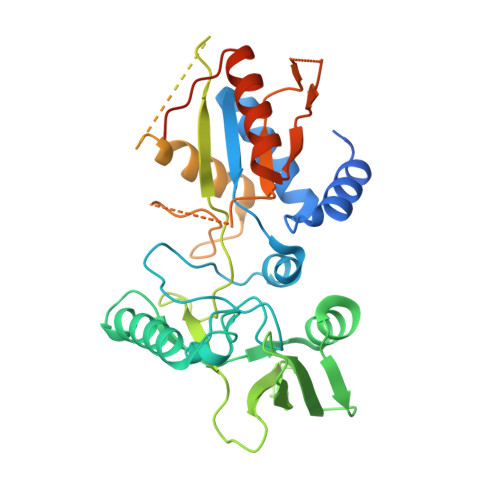Crystal structure and substrate specificity of ExoY, a unique T3SS mediated secreted nucleotidyl cyclase toxin from Pseudomonas aeruginosa
Khanppnavar, B., Datta, S.(2018) Biochim Biophys Acta 1862: 2090-2103
- PubMed: 29859257
- DOI: https://doi.org/10.1016/j.bbagen.2018.05.021
- Primary Citation of Related Structures:
5XNW - PubMed Abstract:
The nucleotidyl cyclase toxin ExoY is an important virulence determinant of Pseudomonas aeruginosa that causes severe acute and chronic infections in immune-compromised individuals. Additionally, this unique T3SS effector shows a striking preference for cUMP, a newly identified non-canonical secondary messenger. Thereby, ExoY is also considered as a potential tool to study unexplored cUMP signaling pathways. The crystal structure of ExoY was determined at 2.2 Å resolutions by in-situ proteolysis assisted crystallization and Rosetta-molecular replacement method. Additionally, isothermal calorimetric (ITC) and molecular dynamic (MD) simulation studies were also carried out to gain molecular insights into its substrate specificity and catalysis. ExoY is a partially unfolded protein with higher propensity to form soluble higher-order oligomers. However, with meticulous attempts of removing of disordered regions by proteases, the recalcitrant ExoY could be successfully crystallized. The crystal structure of ExoY revealed similar overall structural fold present in other anthrax toxA family of nucleotidyl cyclases, with two-to-three distinctly conserved regions conferring specificity to eukaryotic binding partner. The in-vitro catalytic preference of ExoY is in the following order: cGMP > cUMP > cAMP > cCMP. The substrate specificity of ExoY mainly depends on its ability to bind NTP in proper geometrical orientations. ExoY also seems to prefer one-metal-ion dependent catalysis than two-metal-ion dependent catalysis. Our results provide much needed structural insight on ExoY, an important virulence determinant of Pseudomonas aeruginosa and an exciting tool to study non-canonical cNMP signaling pathways. The structure factors and coordinate files have been deposited in the Protein Data Bank with accession number 5XNW.
Organizational Affiliation:
Department of Structural Biology and Bioinformatics, CSIR-Indian Institute of Chemical Biology (CSIR-IICB), Kolkata, India; Academy of Scientific and Innovative Research (AcSIR), India.
















